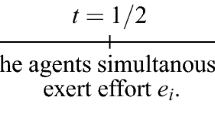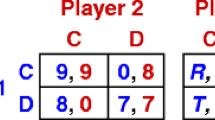Abstract
The paper deals with a theoretical study of the coordination of actions of members of a self-managed team using the Stackelberg strategy aimed at increasing their individual gains. It is assumed that the team creates a total income that increases with the growth of efforts made by each agent and obeys the diminishing return law. The unique Nash equilibrium that exists under the conditions of complete autonomy of all agents is Pareto inefficient. It is shown that for the transition to a Pareto-preferential outcome it suffices to form a small group (coalition) in the team whose members trust each other and are not prone to opportunistic behavior. Following a coalition strategy aimed at achieving the maximum coalition gain, the coalition members increase their efforts; this leads to an increase in the total income. Conditions are found under which the coalition can use the Stackelberg leadership strategy. It is shown that the Stackelberg equilibrium outcome dominates in the sense of Pareto over Nash equilibrium outcomes both in noncooperative and coalitional games.
Similar content being viewed by others
Notes
To make sure that the total payoff \( U \) is higher in the outcome \( P \) than in the outcome \( N \), it suffices to refer to the gradient of the function \( U \). At the Nash equilibrium point \( N \), each coordinate of \( \mathrm {grad}\thinspace U \) is greater than zero; it follows that the function \( U \) reaches higher values at effort levels that exceed the equilibrium.
REFERENCES
Ostrom, E., Governing the Commons. The Evolution of Institutions for Collective Action, Cambridge: Cambridge Univ. Press, 1990. Translated under the title: Upravlyaya obshchim: evolyutsiya institutov kollektivnoi deyatel’nosti, Moscow: IRISEN, 2011.
Kapelyushnikov, R.I., The Plurality of Institutional Worlds: Nobel Prize in Economics 2009, Preprint of Higher School of Economics, Moscow, 2010, no. WP3/2010/02 (part 1).
Holmström, B., Moral hazard in teams, Bell J. Econ., 1982, vol. 13, no. 2, pp. 324–340.
Grossman, S. and Hart, O., The cost and benefits of ownership: a theory of vertical and lateral integration, J. Polit. Econ., 1986, vol. 94, no. 4, pp. 691–719.
Hart, O.D. and Moore, J., Incomplete contracts and renegotiation, Econometrica, 1988, vol. 56, no. 4, pp. 755–785.
Tirole, J., The theory of Industrial Organization. In 2 Vols. Vol. 1 , Cambridge, MA–London: The MIT Press, 1988. Translated under the title: Rynki i rynochnaya vlast’: teoriya organizatsii promyshlennosti. V 2-kh t. T. 1., St. Petersburg: Ekon. Shkola, 2000.
Furubotn, E.G. and Richter, R., Institutions and Economic Theory: The Contribution of the New Institutional Economics, Ann Arbor: Univ. Michigan Press, 1997. Translated under the title: Instituty i ekonomicheskaya teoriya: Dostizheniya novoi institutsional’noi ekonomicheskoi teorii, St. Petersburg: Izd. Dom SPbGU, 2005.
Cournot, A., Researches into the Mathematical Principles of the Theory of Wealth (Original 1838), London: Hafner, 1960.
Stackelberg, H., Marktform und Gleichgewicht, Wien–Berlin: Springer, 1934.
Anderson, S. and Engers, M., Stackelberg versus Cournot oligopoly equilibrium, Int. J. Ind. Organ., 1992, vol. 10, no. 1, pp. 127–135.
Julien, L., Stackelberg games, in Handbook of Game Theory and Industrial Organisation, 2018, vol. 1. ch. 10, pp. 261–311.
Nocke, V. and Shutz, N., Multiproduct-firm oligopoly: an aggregative games approach, Econometrica, 2018, vol. 86, no. 2, pp. 523–557.
Algazin, G.I. and Algazina, D.G., Reflexion processes and equilibrium in an oligopoly model with a leader, Autom. Remote Control, 2020, vol. 81, no. 7, pp. 1258–1270.
Algazin, G.I. and Algazina, D.G., Collective behavior in the Stackelberg model under incomplete information, Autom. Remote Control, 2017, vol. 78, no. 9, pp. 1619–1630.
Geraskin, M.I., Approximate calculation of equilibria in the nonlinear Stackelberg oligopoly model: a linearization based approach, Autom. Remote Control, 2020, vol. 81, no. 9, pp. 1659–1678.
Germeier, Yu.B., Igry s neprotivopolozhnymi interesami (Nonzero-Sum Games), Moscow: Nauka, 1976.
Gorelov, M.A., Activity constraint management model, Probl. Upr., 2019, no. 4, pp. 43–49.
Gubko, M.V. and Novikov, D.A., Teoriya igr v upravlenii organizatsionnymi sistemami (Game Theory in the Management of Organizational Systems), Moscow: Inst. Probl. Upr. im. V.A. Trapeznikova, Ross. Akad. Nauk, 2005.
Novikov, D.A., Matematicheskie modeli formirovaniya i funktsionirovaniya komand (Mathematical Models of the Formation and Functioning of Teams), Moscow: Fizmatlit, 2008.
Skarzhinskaya, E.M. and Tsurikov, V.I., Model of collective action. Part 1. Equilibrium, fairness, efficiency, Ekon. Mat. Metody, 2017, no. 2, pp. 118–133.
Skarzhinskaya, E.M. and Tsurikov, V.I., Model of collective action. Part 2. Leading coalition, Ekon. Mat. Metody, 2017, no. 4, pp. 89–104.
Huck, S. and Rey-Biel, P., Endogenous leadership in teams, J. Inst. Theor. Econ., 2006, vol. 162, no. 2, pp. 253–261.
Gervais, S. and Goldstein, I., The positive effects of biased self-perceptions in firms, Rev. Finance, 2007, vol. 11, no. 3, pp. 453–496.
Kim, J., Endogenous leadership in incentive contracts, J. Econ. Behav. Organ., 2012, vol. 82, no. 1, pp. 256–266.
Skarzhinskaya, E.M. and Tsurikov, V.I., On the possibility of successive approach to equilibrium in a coalition game by repeating collective actions, Ekon. Mat. Metody, 2020, no. 4, pp. 103–115.
Skarzhinskaya, E.M. and Tsurikov, V.I., Endogenous formation of Stackelberg leadership in a team. Coalition formation effect, Zh. Novoi Ekon. Assots., 2021, no. 1 (49), pp. 53–79.
Skarzhinskaya, E.M. and Tsurikov, V.I., Economic and mathematical analysis of the efficiency of the principle “From everybody according to their ability, to everybody according to their work”, Zh. Ekon. Teorii, 2017, no. 2, pp. 110–122.
Skarzhinskaya, E.M. and Tsurikov, V.I., Modeling collective action: the importance of cooperative agreements, Ross. Zh. Menedzh., 2019, no. 3, pp. 337–366.
Author information
Authors and Affiliations
Corresponding authors
Additional information
Translated by V. Potapchouck
Rights and permissions
About this article
Cite this article
Skarzhinskaya, E.M., Tsurikov, V.I. Coordination of Collective Actions by Using the Stackelberg Strategy. Autom Remote Control 83, 1093–1107 (2022). https://doi.org/10.1134/S0005117922070062
Received:
Revised:
Accepted:
Published:
Issue Date:
DOI: https://doi.org/10.1134/S0005117922070062




